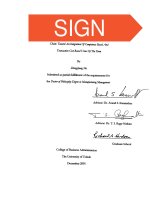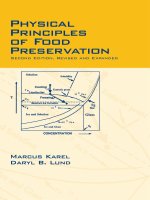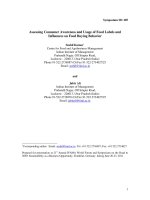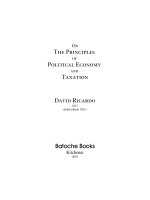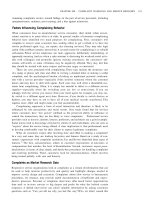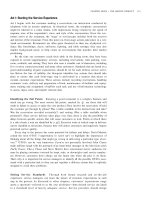Principles of food, beverage and labor cost controls
Bạn đang xem bản rút gọn của tài liệu. Xem và tải ngay bản đầy đủ của tài liệu tại đây (1.88 MB, 593 trang )
PRINCIPLES OF
FOOD, BEVERAGE,
AND LABOR
COST CONTROLS
~
PRINCIPLES OF
FOOD, BEVERAGE,
AND LABOR
COST CONTROLS
Seventh Edition
Paul R. Dittmer
JOHN WILEY & SONS, INC.
This book is printed on acid-free paper.
Copyright ᭧ 2003 by John Wiley & Sons, Inc., New York. All rights reserved.
Published simultaneously in Canada.
No part of this publication may be reproduced, stored in a retrieval system, or
transmitted in any form or by any means, electronic, mechanical, photocopying,
recording, scanning, or otherwise, except as permitted under Sections 107 or 108
of the 1976 United States Copyright Act, without either the prior written permission of the Publisher, or authorization through payment of the appropriate percopy fee to the Copyright Clearance Center, 222 Rosewood Drive, Danvers, MA
01923, (978) 750-8400, fax (978) 750-4744. Requests to the Publisher for permission should be addressed to the Permissions Department, John Wiley & Sons,
Inc., 605 Third Avenue, New York, NY 10158-0012, (212) 850-6011, fax (212) 8506008, E-Mail:
This publication is designed to provide accurate and authoritative information in
regard to the subject matter covered. It is sold with the understanding that the
publisher is not engaged in rendering professional services. If professional advice
or other expert assistance is required, the services of a competent professional
person should be sought.
Wiley also publishes its books in a variety of electronic formats. Some content that
appears in print may not be available in electronic books. For more information
about Wiley products, visit our web site at www.wiley.com.
Library of Congress Cataloging-in-Publication Data
Dittmer, Paul.
Principles of food, beverage, and labor cost controls / Paul R. Dittmer.—7th ed.
p. cm.
ISBN 0-471-39703-2 (cloth : alk. paper)
1. Food service—Cost controls. I. Title.
TX911.3.C65 D57 2002
647.95'068'1—dc21
Printed in the United States of America
10 9 8 7 6 5 4 3 2 1
2001045584
~
Contents
Preface
vii
Acknowledgments
ix
PART I Introduction to Food, Beverage, and Labor Controls
CHAPTER 1
Cost and Sales Concepts
CHAPTER 2
The Control Process
CHAPTER 3
Cost/Volume/Profit Relationships
PART II Food Control
1
3
31
61
81
CHAPTER 4
Food Purchasing Control
83
CHAPTER 5
Food Receiving Control
CHAPTER 6
Food Storing and Issuing Control
CHAPTER 7
Food Production Control I: Portions
CHAPTER 8
Food Production Control II: Quantities
CHAPTER 9
Monitoring Foodservice Operations I: Monthly Inventory and Monthly Food
Cost 205
111
125
151
181
CHAPTER 10
Monitoring Foodservice Operations II: Daily Food Cost
CHAPTER 11
Monitoring Foodservice Operations III: Actual vs. Standard Food Costs
CHAPTER 12
Controlling Food Sales
PART III Beverage Control
233
249
267
309
CHAPTER 13
Beverage Purchasing Control
311
CHAPTER 14
Beverage Receiving, Storing, and Issuing Control
CHAPTER 15
Beverage Production Control
337
359
v
vi
Contents
CHAPTER 16
Monitoring Beverage Operations
CHAPTER 17
Beverage Sales Control
PART IV Labor Control
385
415
431
CHAPTER 18
Labor Cost Considerations
CHAPTER 19
Establishing Performance Standards
CHAPTER 20
Training Staff
CHAPTER 21
Monitoring Performance and Taking Corrective Action
Afterword
433
455
489
527
Appendix: Cost/Volume/Profit In-Depth Analysis
Glossary
Index
543
563
529
509
~
Preface
This text has been developed for use in courses introducing food,
beverage, and labor cost controls to students preparing for careers
in food and beverage management as well as hotels and other enterprises where this knowledge is necessary. This edition consists
of twenty-one chapters plus an appendix, divided into four parts,
as follows.
Part I offers an introduction to food, beverage, and labor cost
controls, defining a number of key terms and concepts and providing a foundation for the balance of the work as well as some sense
of its scope. It identifies working definitions for the terms cost and
sales, discusses the control process in some detail, and introduces
the basics of cost/volume/profit analysis.
Part II addresses the application of the four-step control process to the primary phases of foodservice operations: purchasing,
receiving, storing, issuing, and production. Specific techniques and
procedures for each phase are explained and discussed in detail.
Three chapters are devoted to determining costs and using them
as monitoring devices in foodservice operations. One chapter deals
specifically with food sales control, offering a broad definition of the
term and providing detailed discussion of several approaches to
sales control.
Part III discusses the application of the four-step control process to the various beverage operations: purchasing, receiving,
storing, issuing, and production. Here, too, specific techniques and
procedures for each phase are explained and discussed in detail.
One chapter is devoted to the principal methods used to monitor
beverage operations. The final chapter in Part III specifically addresses beverage sales control, offering a broad definition of the
term and providing detailed discussion of several approaches to
controlling beverage sales.
Part IV is a four-chapter exposition of labor cost control. The first
of the four explores the factors affecting labor cost and labor cost
percentage. Admittedly, some of these are beyond the control of
management, but it is important for managers to know about them.
The second chapter discusses the need for performance standards.
This leads naturally to a chapter on training, a topic many believe to
vii
viii
Preface
be central to labor cost control. The concluding chapter in Part IV
deals with monitoring performance and taking corrective action.
The appendix is an expansion of Chapter 3, “Cost/Volume/
Profit Relationships.” It is designed for students desiring a more indepth understanding of this important topic. The material in the
appendix, while important, is not necessary for an understanding
of the principles discussed in the text.
The author recognizes that most food and beverage operations
are computerized to some extent. Thus, each of the chapters in Parts
I, II, and III has a concluding section dealing with computer operations; and Excel᭨ computer exercises are provided at the end of each
chapter, utilizing the floppy diskette found in the back of this book.
In developing and revising the text, flexibility has always been
a key concern. For example, each of the four parts can generally
stand alone. Except for Part I, eliminating any other part will not
make it difficult to use the remaining parts. Thus, in courses without beverage components, instructors may prefer to skip Part III.
And instructors in courses that do not include labor cost control
can choose to ignore Part IV.
The book has a greater number of chapters than many instructors use in a one-term course. In our view, this is a virtue, because
it provides instructors with opportunities to select chapters dealing
with specific topics identified in their course syllabus. We believe
this is the best way to meet the varying needs of instructors in the
broad range of courses and programs in this field.
Because a great many chapters include more questions and
problems than most will be inclined to assign, instructors will find
it easy to make selective use of the end-of-chapter exercises for
written assignment or for in-class discussion.
Supplementary Materials
An Instructor’s Manual (ISBN 0-471-20778-0) to accompany the
textbook is available to qualified adopters upon request from the
publisher. It contains answers to the end-of-chapter questions and
problems, along with various other materials designed to assist in
the classroom.
The National Restaurant Association (NRA) Educational Foundation, in consultation with the author, has developed a Student
Workbook for its ProMgmt. certificate program. The workbook contains exercises and a study outline for each chapter, and a practice
test of 80 multiple-choice questions. This practice test will assist
students in preparation for the certificate examination.
In addition, an Instructor’s Guide (ISBN 0-471-20876-0) is
available to qualified adopters to complement and highlight the information in the textbook and Student Workbook.
~
Acknowledgments
In revising this work, the author sincerely thanks Michael O’Fallon,
Washington State University, and Marc Lubetkin, University of
Houston, for their assistance in reviewing the manuscript of the
Seventh Edition and suggesting changes and additions to the Sixth
Edition.
In addition, the author would like to acknowledge reviewers of
the previous editions:
Patricia S. Bartholomew, Frank C. Constantino, Stephen K.
Holzinger, and Fedele J. Panzarino, New York Technical College of
the City University of New York; Julie Rain, New Hampshire College; Warren Sackler, Rochester Institute of Technology; Robert A.
Heath and Edward F. McIntyre, Birmingham (U.K.) College of Food,
Tourism, and Creative Studies; Kevin Bedard, of Canopy’s Training
Restaurant, a program of the Educational Opportunity Center,
State University of New York at Brockport; Andrew R. Schwarz, Sullivan Country Community College; Allan Sherwin, Lundeberg
School of Seamanship; James A. Bardi, the Berks Campus of Pennsylvania State University; Mary Ann Carroll, Keystone Junior College; George G. Fenich, University of New Orleans; John Drysdale,
Johnson Country Community College; Frederick Laughlin, Jr.,
Northwestern Michigan College; Earl Arrowwood, Jr., Bucks Country Community College; Rodney Rudolph, State University of New
York of Technology at Delhi; John Stefanelli, University of Nevada,
Las Vegas; Wallace Rande, Northern Arizona University; Paul
McVety, Johnson and Wales University; David Tucker, Widener
University; Charles Latour, Northern Virginia Community College;
Larry Ross, Georgia State University; Michael Evans, Appalachian
State University; Chris Letchinger, Kendall College; Anthony
Bruno, Nassau Community College; Don St. Hilaire, California
State Polytechnic University-Pomona.
Particular thanks goes to Millie Torres, Associate Managing Editor at John Wiley & Sons, for her outstanding work in preparing
the Seventh Edition for publication.
If this edition of the text is successful, proving to be a useful
addition to the growing number of professional texts available for
ix
x
Acknowledgments
those planning careers in food and beverage management, a
healthy measure of credit will be due to the many individuals whose
help we have acknowledged above. If not—if the work is somewhat
off the mark—the author accepts full responsibility for the shortcomings.
PRINCIPLES OF
FOOD, BEVERAGE,
AND LABOR COST
CONTROLS
~
PART I
Introduction to
Food, Beverage,
and Labor Controls
~
CHAPTER 1
Cost and Sales Concepts
Learning Objectives
After reading this chapter, you should be able to:
1. Define the terms cost and sales.
2. Define and provide an example of the following types of costs:
fixed, directly variable, semivariable, controllable, noncontrollable, unit, total, prime, historical, and planned.
3. Provide several examples illustrating monetary and nonmonetary sales concepts.
4. Describe the significance of cost-to-sales relationships and
identify several cost-to-sales ratios important in food and beverage management.
5. Identify the formulas used to compute the following: cost percent, sales price, maximum allowable cost per person.
6. Describe factors that cause industry-wide variations in cost
percentages.
7. Explain the value of comparing current cost-to-sales ratios with
those for previous periods.
Introduction
The Rush Hour Inn
Until she decided to purchase a restaurant two years ago, Kim
Rusher had been a successful advertising executive. Her annual
income was substantial, and she augmented it by investing in some
profitable real estate ventures with her brother. However, her position in advertising required that she travel several days a week,
and over time the travel became wearisome to her. This made her
3
4
CHAPTER 1
Cost and Sales Concepts
decide to give up the advertising business in favor of operating her
own business.
On the advice of her brother, she decided to go into the restaurant business even though she lacked previous experience in the
field. After all her years of travel, she thought she knew more about
restaurants from the customer’s point of view than most restaurateurs. So she began to look around for an appropriate property.
Fortunately, she soon found a place just 12 miles from her home,
located on a main road on the outskirts of a city of 75,000 people.
The building and equipment were only six years old and apparently
in fine condition, and the retiring owner was anxious to sell at a
very fair price. The owner’s books revealed a successful operation,
with a restaurant profit of approximately $165,000 per year. Kim
Rusher decided to buy. The restaurant had 100 seats. It was open
seven days a week, from 6:00 A.M. to 10:00 P.M., serving a varied
menu of standard American fare. Kim believed she would be able
to run it successfully with a small and dedicated staff.
In the first year, Kim’s profits were less than those of the previous owner. After two years, profits were continuing to decline. The
restaurant was simply not showing an adequate profit, even though
Kim had increased the volume of business over that of the previous
owner. The place was reasonably busy, her customers often complimented her on the food, and her staff appeared to be loyal and
helpful in every way. The truth was that Kim Rusher was operating
a popular, but not very profitable, food and beverage business. At
the end of the second full year of operation, the statement of income
prepared by her accountant revealed a restaurant profit of $36,117
(Figure 1.1).
It quickly became apparent to Kim, her family, and her accountant that unless something could be done to make the restaurant
more profitable, the operation would not be worth the effort required.
The Graduate Restaurant
Just a few miles down the road from the Rush Hour Inn, Bill Young
owns and operates the Graduate Restaurant. After four years in
the air force, Bill had worked for an insurance company for a few
years before enrolling in a nearby college to study hospitality management. His interest in the food and beverage sector of the hospitality industry began in his high school days when he worked part
time in the local unit of a national fast-food chain. Although his
interest had grown steadily over the years, it took considerable
courage for him to give up a fairly promising insurance career to go
back to school. He earned a degree in hospitality management and
then went to work as the assistant manager in a local restaurant.
5
Introduction
INCOME STATEMENT
Year Ended December 31, 200X
Sales
Food
Beverage
Total Sales
Cost of Sales
Food
Beverage
Total Cost of Sales
Gross Profit
Controllable Expenses
Salaries and Wages
Employee Benefits
Other Controllable Expenses
Total Controllable Expenses
Income Before Occupancy Costs,
Interest, Depreciation, and Income Taxes
Occupancy Costs
Interest
Depreciation
Total
Restaurant Profit
$
1,533,400.00
270,600.00
$ 1,804,000.00
$
644,028.00
86,592.00
$ 730,620.00
$ 1,073,380.00
$
$
$
$
$
$
487,080.00
121,770.00
220,600.00
$
$
829,450.00
243,930.00
$
$
207,813.00
36,117.00
120,553.00
27,060.00
60,200.00
Figure 1.1 The Rush Hour Inn income statement
Over the next several years he worked in three food and beverage
operations in the area, including the Rush Hour Inn, before deciding that he was ready to own and operate his own restaurant.
With the help of his family and a local bank, Bill was able to
purchase the Graduate Restaurant, a fairly popular establishment
with the same type of menu as the Rush Hour Inn as well as comparable prices and hours of operation. In fact, the only differences
to the casual observer were size and location: The Graduate Restaurant had only 50 seats and was in a somewhat less favorable
location.
Under the previous owner, the restaurant had shown a profit
of $65,000 per year. But Bill felt sure he could increase the profit
by applying the principles he had learned in the college’s hospitality
management program. The employees he inherited with the restaurant were both loyal and cooperative, and he found them receptive to the changes that he made gradually over the first year of
operation. None of the changes were dramatically apparent to the
customers; in fact, at the end of the first year, most had not noticed
any changes at all. In general, they were as pleased with the establishment as they had been when Jim first took it over, and they
6
CHAPTER 1
Cost and Sales Concepts
continued to return. In addition, newcomers tried the restaurant,
liked it, and became regular customers. At the end of the first full
year of operation, Bill’s accountant presented him with a statement
of income showing a restaurant profit of $106,375 (Figure 1.2).
The statement confirmed Bill’s expectations. It proved to him
that his management of the operation was effective in the ways he
had anticipated. At the end of his first year, he looked to the future
with confidence.
A comparison of the statements of income for these two restaurants reveals some very important facts. As one might expect, the
Rush Hour Inn, with twice as many seats as the Graduate Restaurant, as well as a comparable menu and comparable prices, shows
approximately twice the dollar volume of sales. However, in spite of
the apparently favorable sales comparison, the restaurant profit for
the Rush Hour Inn is considerably less than the Graduate Restaurant. Because the difference between sales and restaurant profit on
each statement of income is represented by costs of various kinds,
INCOME STATEMENT
Year Ended December 31, 200X
Sales
Food
Beverage
Total Sales
Cost of Sales
Food
Beverage
Total Cost of Sales
Gross Profit
Controllable Expenses
Salaries and Wages
Employee Benefits
Other Controllable Expenses
Total Controllable Expenses
Income Before Occupancy Costs,
Interest, Depreciation, and Income Taxes
Occupancy Costs
Interest
Depreciation
Total
Restaurant Profit
$ 786,250.00
$ 138,750.00
$ 925,000.00
$ 275,187.00
$ 34,688.00
$ 309,875.00
$ 615,125.00
$ 185,000.00
$ 46,250.00
$ 138,750.00
$ 370,000.00
$ 245,125.00
$
$
$
78,625.00
13,875.00
46,250.00
Figure 1.2 The Graduate Restaurant income statement
$ 138,750.00
$ 106,375.00
Cost Concepts
7
we can infer that part of the difficulty with the Rush Hour Inn is
somehow related to cost. The costs of operation seem to be in more
favorable proportion to sales in the Graduate Restaurant. Initially,
we must look to the nature of these costs and their relations to sales
to find the differences between the two establishments. It is possible that the costs of operation are not well regulated, or controlled, by the Rush Hour Inn. It is also possible that sales are not
well controlled and that if Kim Rusher is going to increase her profit
to a desirable level, she must begin by exercising greater control
over the several kinds of operating costs, as well as over sales.
The statement of income from the Graduate Restaurant suggests that Bill Young has kept both costs and sales under control,
and, as we shall see, this is critically important to the success of
his business. Comparative investigation of the two restaurants
would reveal that Bill Young had instituted various control procedures in the Graduate Restaurant that are noticeably absent in Kim
Rusher’s business. These control procedures are important features of a computer program that plays a significant part in the
operation of the Graduate Restaurant. These procedures have enabled Jim to manage his business more effectively. It will be important, therefore, to look closely at the nature and effect of these
control procedures in succeeding chapters. However, before proceeding, it will be useful to establish clear definitions of the terms
cost, sales, and control. Cost and sales will be defined and discussed in this chapter; control will be covered in Chapter 2.
Cost Concepts
Definition of Cost
Accountants define a cost as a reduction in the value of an asset
for the purpose of securing benefit or gain. That definition, although technically correct, is not very useful in a basic discussion
of controls, so we will modify it somewhat.
As we use the term in our discussion of cost control in the food
and beverage business, cost is defined as the expense to a hotel or
restaurant for goods or services when the goods are consumed or
the services are rendered. Foods and beverages are considered
“consumed” when they have been used, wastefully or otherwise,
and are no longer available for the purposes for which they were
acquired. Thus, the cost of a piece of meat is incurred when the
piece is no longer available for the purpose for which it was purchased, because it has been cooked, served, or thrown away because it has spoiled, or even because it has been stolen. The cost
8
CHAPTER 1
Cost and Sales Concepts
of labor is incurred when people are on duty, whether or not they
are working and whether they are paid at the end of a shift or at
some later date.
The cost of any item may be expressed in a variety of units:
weight, volume, or total value. The cost of meat, for example, can
be expressed as a value per piece, per pound, or per individual portion. The cost of liquor can be expressed as a value per bottle, per
drink, or per ounce. Labor costs can be expressed as value per hour
(an hourly wage, for example) or value per week (a weekly salary).
Costs can be viewed in a number of different ways, and it will
be useful to identify some of them before proceeding.
Fixed and Variable Costs
The terms fixed and variable are used to distinguish between those
costs that have no direct relationship to business volume and those
that do.
Fixed Costs
Fixed costs are costs that are normally unaffected by changes
in sales volume. They are said to have little direct relationship to
the business volume because they do not change significantly when
the number of sales increases or decreases. Insurance premiums,
real estate taxes, and depreciation on equipment are examples of
fixed costs. Real estate taxes, after all, are set by governmental authorities and are based on government’s need for a determined
amount of total revenue. The taxes for an individual establishment
are based on the appraised value of the assessed property as real
estate. Real estate taxes do not change when the sales volume in
an establishment changes.
All fixed costs change over time, of course, sometimes increasing and sometimes decreasing. However, changes in fixed costs are
not normally related to short-term changes in business volume.
They are sometimes tied indirectly to long-term volume changes.
For example, an increase in the cost of insurance premiums may
be attributable to an insurance company’s perception of increased
risk associated with higher volume. Even though the increase in
insurance cost is somehow related to an increase in volume, the
cost of insurance is still considered a fixed cost. Advertising expense is another example: Larger establishments tend to spend
more on advertising because their larger sales volume makes larger
amounts of money available for the purpose, but advertising expense is still considered a fixed cost.
The term fixed should never be taken to mean static or unchanging, but merely to indicate that any changes that may occur
in such costs are related only indirectly or distantly to changes in
Cost Concepts
9
volume. Sometimes, in fact, changes in fixed costs are wholly unrelated to changes in volume, as with real estate taxes. Other examples of costs that are generally considered fixed include repairs
and maintenance, rent or occupancy costs, most utility costs, and
the costs of professional services, such as accounting.
Variable Costs
Variable costs are costs that are clearly related to business
volume. As business volume increases, variable costs will increase;
as volume decreases, variable costs should decrease too. The obvious examples of variable costs are food, beverages, and labor.
However, there are significant differences between the behavior of
food and beverage costs and the behavior of labor costs.
Food and beverage costs are considered directly variable costs.
Directly variable costs are those that are directly linked to volume
of business, so that every increase or decrease in volume brings a
corresponding increase or decrease in cost. Every time a restaurant
sells an order of steak, it incurs a cost for the meat. Similarly, each
sale of a bottle of beer at the bar results in a cost for the beer. Total
directly variable costs, then, increase or decrease—or at least
should increase or decrease—in direct proportion to sales volume.
Payroll costs (including salaries and wages and employee benefits, and often referred to as labor costs) present an interesting
contrast. Foodservice employees may be divided into two categories—those whose numbers will remain constant despite normal
fluctuations in business volume, and those whose numbers and
consequent total costs should logically (and often will) vary with
normal changes in business volume. The first category includes
such personnel as the manager, bookkeeper, chef, and cashier. In
terms of the preceding definition, they are fixed-cost personnel.
Their numbers and costs may change, but not because of shortterm changes in business volume. The second category includes
the servers, or the waitstaff. As business volume changes, their
numbers and total costs can be expected to increase or decrease
accordingly.
Both fixed-cost and variable-cost employees are included in one
category on the statement of income: “Salaries and Wages.” Because payroll cost has both the fixed element and the variable element, it is known as a semivariable cost, meaning that a portion
of it should change with short-term changes in business volume,
and another portion should not.
It must be noted that each individual establishment must make
its own determination of which employees should be fixed-cost personnel and which should be variable-cost. In some specialized
cases, it is possible for payroll to consist entirely of either fixed-cost
or variable-cost personnel. For example, there are some restau-
10
CHAPTER 1
Cost and Sales Concepts
rants in which the entire staff works for hourly wages. In these
cases, numbers of hours worked and consequent costs are almost
wholly related to business volume. Conversely, in some smaller restaurants employees may all be on regular salaries, in which case
labor cost is considered fixed.
Controllable and Noncontrollable Costs
Costs may also be labeled controllable and noncontrollable. Controllable costs are those that can be changed in the short term.
Variable costs are normally controllable. The cost of food or beverages, for example, can be changed in several ways—by changing
portion sizes, by changing ingredients in a recipe, or by changing
the quality of the products purchased.
The cost of labor can be increased or decreased in the short
term by hiring additional employees or by laying some off, by increasing or decreasing the hours of work, or, in some instances, by
increasing or decreasing wages.
In addition, certain fixed costs are controllable, including advertising and promotion, utilities, repairs and maintenance, and
administrative and general expenses, a category that includes office supplies, postage, and telephone expenses, among others. It is
possible for owners or managers to make decisions that will change
any of these in the short term.
In contrast, noncontrollable costs are those that cannot normally be changed in the short term. These are usually fixed costs,
and a list of the more common ones would include rent, interest on
a mortgage, real estate taxes, license fees, and depreciation. Managers do not normally have the ability to change any of these in the
near term.
Unit and Total Costs
It is also important to distinguish between unit costs and total
costs. The units may be food or beverage portions, as in the cost of
one steak or one martini, or units of work, as in the hourly rate for
an employee. It is also useful to consider costs in terms of totals,
as in the total cost of all food served in one period, such as a week
or a month, or the total cost of labor for one period. The costs on a
statement of income are all total costs, rather than unit costs.
These concepts are best illustrated by example. In Sherwin’s
Steak House, a restaurant where steaks are cut from strip loins, a
strip loin was purchased for $63.75. If one entire strip were consumed in one day, the total cost would be $63.75. However, the
cost per unit (the steak) depends on the number of steaks cut from
the strip. If there are 15, the unit cost is an average of $4.25. No 2
Cost Concepts
11
of the 15 are likely to have identical costs, because it is not normally
possible for a butcher to cut all steaks to exactly the same weight.
In the food and beverage business we commonly deal with average
unit costs, rather than actual unit costs. It is important to know
unit costs for purposes of establishing menu prices and determining unit profitability. Total costs, including those that appear in
statements of income, are normally used for broader purposes, including the determination of the relationship between total costs
and total sales—as discussed later in this chapter—and for determining overall profitability of operations.
It is important to note that, as business volume changes, total
and unit costs are affected in different ways. Assume that a restaurant has a fixed cost for rent of $2,000 per month. If 2,000 customers were served during a period of one month, the fixed cost of rent
per customer would be $1. If, in the succeeding month, the number
of customers increased to 4,000, the total fixed cost for rent would
not change, but the fixed cost per unit (customer) would be reduced
from $1.00 to $.50.
A similar analysis may be done with variable costs. The variable
cost for the steak described earlier is $4.25 per unit. If 2,000 customers in a given month order steak, the total variable cost would
be $8,500, at $4.25 average unit cost per steak. If, in the following
month, 4,000 customers order steak, the variable cost per unit (the
steak) should remain at $4.25, whereas the total variable cost for
4,000 steaks increases to $17,000.
The preceding paragraphs illustrate cost behavior only as business volume increases, but it is important to recognize that costs
behave similarly as business volume decreases. The relationships
hold true. Figure 1.3 illustrates the behavior of fixed and variable
costs per unit and in total, as discussed earlier.
Cost Behavior as Business Volume Changes
Fixed Cost
Variable Cost
Unit Costs
Total Cost
Changes
Does not change
Does not change
Changes
It must be noted that this relationship does not always hold true.
As volume increases some variable costs have a tendency to decrease.
This is particularly true with variable labor costs, because workers
become more productive with greater time utilization. Food can be
purchased cheaper in larger quantities and can thus reduce variable
costs.
Figure 1.3 Cost behavior as business changes



